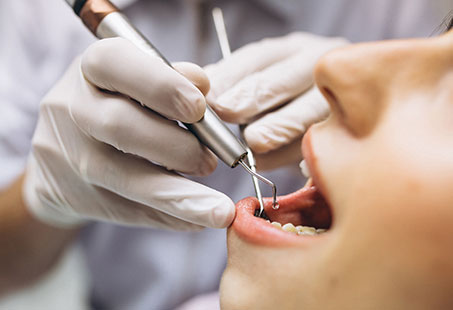While it definitely doesn’t seem so, the enamel is the hardest substance in your body. Even your bones aren’t as strong as the enamel on your teeth.
Without this enamel, your teeth are vulnerable to all sorts of oral health problems. And this is what happens when you have enamel hypoplasia.
Enamel hypoplasia refers to the defect in the development of the enamel in terms of both quality and quantity. And since this is a developmental defect, children are more susceptible to it. They might not even be aware of what’s happening.
Also, those who suffer from this problem often wonder whether it is something they are doing that causes it. For these reasons, you need to understand what enamel hypoplasia is and how to deal with it.
What Is Enamel Hypoplasia?
Dental enamel hypoplasia is a developmental defect of enamel that results in a deficient or defective enamel. This condition will affect your teeth while they’re still developing. So both baby and adult teeth are affected.
Enamel hypoplasia is, however, not that common. Research published in the European Archives of Paediatric Dentistry showed that this condition had a prevalence rate of 6.1% among children aged 2-5.
One thing to keep in mind is that enamel hypoplasia is not a disease. It’s indicative of some kind of stress that you experienced. This stress upsets the secretion of the enamel matrix, which inhibits its normal development.
And remember that enamel cannot be regrown. So, enamel hypoplasia is not reversible. Depending on the severity of the problem, you’ll have to seek protective treatments. In this way, you can prevent further dental damage.
What Does Enamel Hypoplasia Look Like?
Enamel hypoplasia teeth are characterised by having pits, depressions, and grooves on their surface.
The erosion of the enamel due to this condition will also result in the formation of white spot lesions. You might also have orange, yellow or brown-coloured stains on your teeth.
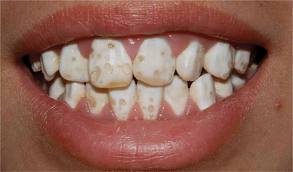
Additionally, hypoplastic teeth can also feel softer because of enamel erosion, and they may be smaller in size.
Other than that, cavities are also more common in people who have enamel hypoplasia. And weakened teeth can also chip quite easily.
What Are The Different Types of Enamel Hypoplasia?
Depending on the shape or location of the enamel hypoplasia, there are various types. These are as follows:
- Plane-Form Enamel Hypoplasia – When the secretion of the enamel matrix is completely or partly disrupted, the tooth ends with some or no enamel at all. This is plane-form enamel hypoplasia, according to a study published in the Dental Anthropology Journal.
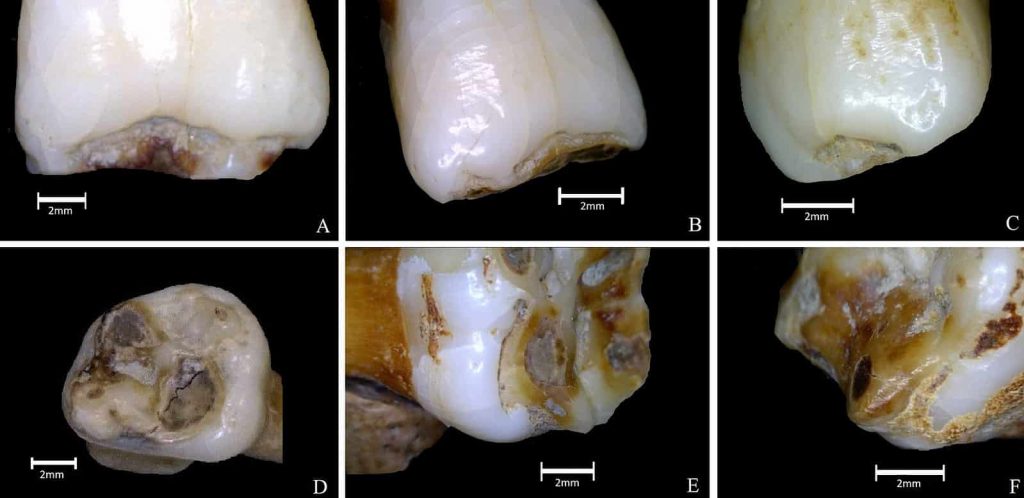
- Linear Enamel Hypoplasia – In this, symmetrical rings or bands of incomplete enamel are seen on the surface of the teeth.
- Pitted Enamel Hypoplasia – Pits or depressions on the surface of the tooth are indicative of pitted enamel hypoplasia.
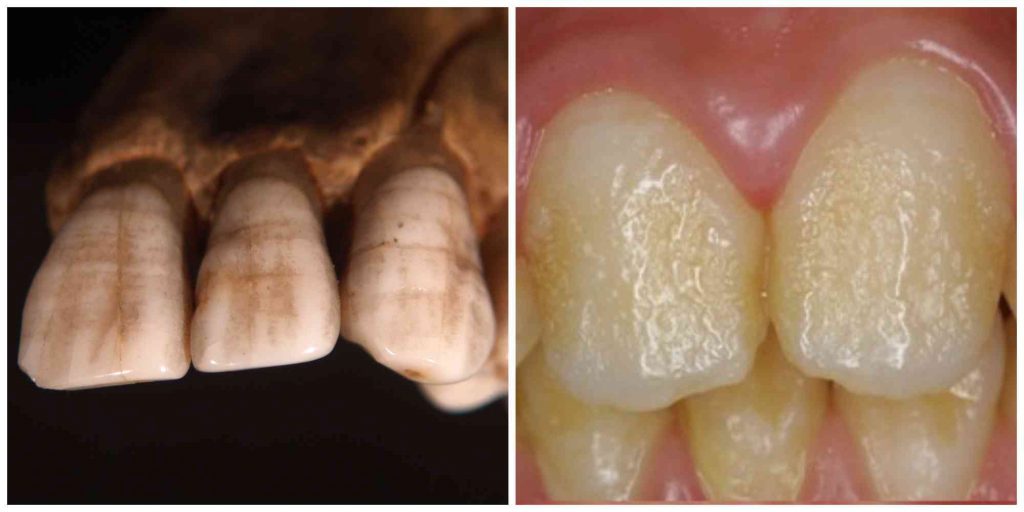
Research published in the Journal of Clinical & Diagnostic Research also describes a rare circular enamel hypoplasia. It resulted in the formation of a “demarcating line” around the crowns of the tooth that experienced trauma.
What Causes Enamel Hypoplasia?
Enamel hypoplasia can result from a combination of genetic and environmental factors. These stressors can include hereditary conditions, prenatal issues and environmental insults. All these can disrupt the normal secretion of the enamel matrix.
Let’s take a closer look at these factors in more detail.
Inherited Conditions
Dental enamel hypoplasia can be congenital due to inherited health conditions. These include:
- Amelogenesis imperfecta
- Usher syndrome
- Treacher-Collins syndrome
- Seckel-syndrome
- 22q11 deletion syndrome
- Ellis-van Creveld syndrome
- Heimler syndrome
- Otodental syndrome
So enamel hypoplasia can develop on its own or as a symptom of another syndrome.
Issues Before Birth
Poor maternal health, nutrition and lifestyle can also result in enamel defects. This may happen as a result of:
- Smoking
- Vitamin D deficiency
- Drug abuse
- High fever around birth
- Poor antenatal care
Premature birth and low birth weight may also lead to the development of this condition.
Environmental Insults
Enamel development can also be disrupted due to environmental factors. These may include:
- Hypoxia
- Exposure to toxic chemicals
- Nutritional deficiencies (calcium, vitamins, magnesium)
- Intubation premature infant
- Trauma
- Infection
- Kidney disease
- Liver disease
- Celiac disease
Some people also wonder if eating too much sugar causes enamel hypoplasia. Although sugar can negatively affect enamel, there is no evidence that it can cause enamel hypoplasia.
How To Get Rid Of Enamel Hypoplasia?
Enamel hypoplasia treatment depends on the severity of the problem. For instance, if the problem is mild, your dentist may place dental sealants on the affected teeth and recommend the use of fluoride toothpaste. They will also make sure to monitor the teeth.
If the problem is moderate, you may be recommended composite resins, amalgam or gold fillings to prevent further damage. However, if the tooth is quite weak, a dental crown might be recommended instead. It’s stronger and more durable than fillings. Additionally, a crown will cap the entire tooth, protecting it from all sides.
Lastly, though, if the tooth is too badly damaged and restoration is not possible, it may have to be extracted entirely. In this case, you may be recommended implants with a crown to replace the missing tooth.
There are additional treatment options that can strengthen the teeth and address the cosmetic issues that can result from enamel hypoplasia. These can include:
- Enamel Microabrasion – An acid and dental abrasive are used to remove superficial stains from the surface of the teeth to improve their appearance.
- Teeth Whitening – Teeth are bleached to get rid of the stains on the surface.
- Resin Infiltration – Resin material is applied to the outer surface of the tooth to hide discolouration.
- Fluoride Varnish – Fluoride-containing varnish or gel is applied to the teeth to remineralise the teeth, strengthen the enamel and prevent tooth decay.
- CPP-ACP – Casein phosphopeptide–amorphous calcium phosphate-nanocomplexes (CPP-ACP) also helps remineralise the teeth and prevent tooth decay.
In any case, you need to consult a board-certified and registered dentist. They’ll recommend a suitable treatment plan.
Can Enamel Hypoplasia Be Fixed?
The damage caused by enamel hypoplasia is permanent, but it can be treated.
Your enamel will not grow back on its own, so you will have to seek treatment to address problems resulting from this condition.
And it’s important that you seek treatment as quickly as possible so that your teeth don’t end up with extensive damage.
Does Enamel Hypoplasia Affect All Teeth?
Enamel hypoplasia doesn’t always affect all teeth. Sometimes, it only affects a few teeth.
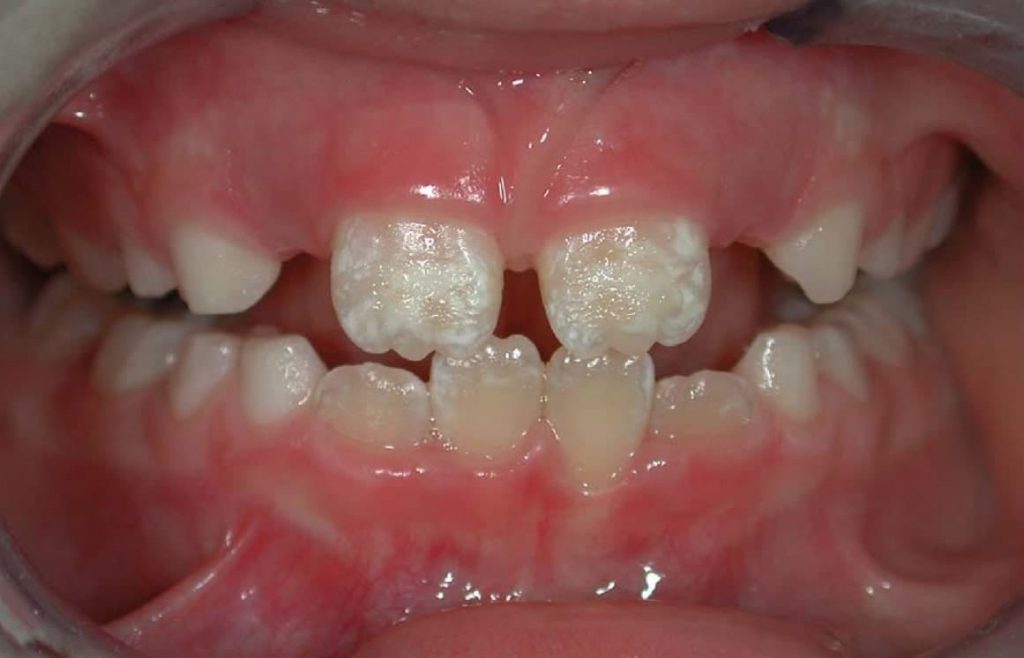
According to research published in the American Journal of Physical Anthropology, trauma and infection can lead to enamel hypoplasia on one tooth or adjacent teeth.
However, inherited conditions can result in enamel hypoplasia across all teeth.
How To Prevent Enamel Hypoplasia?
By avoiding some of the prenatal and environmental risk factors, you may be able to prevent enamel hypoplasia, but it’s not always possible. That’s because you cannot control inherited conditions.
But if you already have enamel hypoplasia, you may be able to prevent further damage to the teeth by taking the following measures:
- Brush twice a day with fluoride toothpaste.
- Do not consume too many sugary and acidic foods.
- Eat foods that strengthen the teeth (cheese, milk, vegetables, high-fibre fruits)
- Get regular dental checkups.
Due to the sensitivity that enamel erosion causes, people with this condition might have difficulty taking care of their teeth. Certain things can help. For instance, don’t use water that’s too hot or cold when brushing your teeth. Make sure it’s lukewarm.
Also, make sure that you use a soft toothbrush; hard bristles can cause even more wear and tear.
Conclusion
Enamel hypoplasia is a developmental defect, and you can’t always prevent it. However, it’s important to get treated for it as soon as possible. This is because an enamel that is thin and weak can cause tooth decay and even tooth loss.
There are different restorative and cosmetic treatments that can help you. But it’s also important that you take care of your teeth by brushing and eating well.
For discussing different treatment options, make sure to get in touch with a qualified dental professional.
FAQ
Is enamel hypoplasia treatment available on the NHS?
You may be able to get treatment for hypoplastic enamel on the NHS. The treatment plan will vary depending on the severity of the problem. You may be able to get veneers, teeth whitening, microabrasion, etc.
What’s Turner’s hypoplasia?
Turner hypoplasia results from a defect in the secretion phase of the enamel formation. However, Turner hypoplasia or Turner’s tooth, refers to just one tooth being affected.
How to differentiate enamel hypoplasia from fluorosis?
Like enamel hypoplasia, fluorosis (from too much fluoride) can result in white spots or streaks on the teeth. However, in fluorosis, the teeth start to lose their transparency while the enamel remains unaffected.
What’s the difference between amelogenesis imperfecta and enamel hypoplasia?
Amelogenesis imperfecta (AI) is a group of genetic conditions that affect the normal development of the enamel. Enamel hypoplasia is just one type of it.
What’s the difference between enamel hypoplasia and hypomineralization?
Both enamel hypoplasia and hypomineralization are enamel defects, but they occur at different phases of enamel formation. The former occurs during the secretion phase, while the latter occurs during the mineralisation phase.
What’s the difference between enamel hypocalcification and enamel hypoplasia?
Enamel hypocalcification is a result of insufficient calcium but it doesn’t affect the quantity of the enamel like enamel hypoplasia.
Reviewed and Approved by Dr Izbel Aksit
